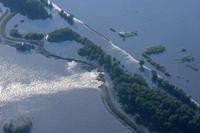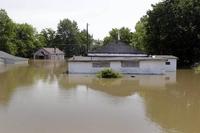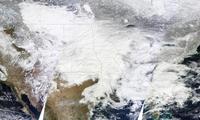-
The causes of massive snow storms
Three storms spanning from December to February in the winter of 2009-10 had dumped a whopping 54.9 inches of snow on the Baltimore-Washington area; the snowfall broke a seasonal record first set in 1899; Snowmaggedon, as the winter was dubbed, entered the history books as the snowiest winter on record for the U.S. East Coast
-
-
Understanding how earthquakes work
Geologists have a new tool to study how earthquakes change the landscape down to a few inches, and it is giving them insight into how earthquake faults behave
-
-
Local officials oppose “unacceptable” levee ratings

In recent years as part of an effort to bolster the nation’s flood protection infrastructure, the Army Corps of Engineers has analyzed and declared more than 200 levee systems across the country as “unacceptable,” resulting in a firestorm of criticism from local officials
-
-
Disasters hurt Honda’s production, lower revenue
On Tuesday Japanese auto manufacturer Honda Motor Company announced that it had slashed its annual profit guidance as a result of the natural disasters in Japan and Thailand
-
-
Sea water could corrode nuclear fuel
Japan used seawater to cool nuclear fuel at the stricken Fukushima-Daiichi nuclear plant after the tsunami in March 2011 — and that was probably the best action to take at the time; scientists have since discovered a new way in which seawater can corrode nuclear fuel, forming uranium compounds that could potentially travel long distances, either in solution or as very small particles
-
-
Tsunami debris spread across Pacific Ocean
The 11 March 2011 tsunami in Japan washed millions of tons of debris into the Pacific; scientists have been trying to track the trajectory of this debris that can threaten small ships and coastlines
-
-
Insurance companies predict increase in premiums

Even after all the flood waters have receded and power has been restored, New Jersey homeowners will still have to suffer the consequences of Hurricane Irene; according to insurance industry representatives and analysts, homeowners and businesses will likely see their insurance premiums increase over the next several years
-
-
Midwest preps for multi-state earthquake drill
Emergency management agencies across the central United States are getting ready for a multi-state earthquake preparedness drill next month; led by the University of Southern California’s Earthquake Center, on 7 February at 10:15 AM CST, more than one million people across nine states will participate in the “Great Central U.S. ShakeOut”
-
-
Floating life capsule can save lives in tsunami

Following the devastating earthquake and tsunami that left roughly 20,000 people dead in Japan, Japanese engineers have been hard at work developing innovative solutions to help save lives in the event of another major disaster; one such invention is Noah, a floating capsule that holds up to four people
-
-
World’s first magnetic soap can clean oil spills

A University of Bristol team has dissolved iron in liquid surfactant to create a soap that can be controlled by magnets; the discovery could be used to create cleaning products that can be removed after application and used in the recovery of oil spills at sea
-
-
Restored wetlands rarely equal condition of original wetlands
Wetlands provide many societal benefits such as biodiversity conservation, fish production, water purification, erosion control, carbon storage; along the coast, they also serve as natural barrier which moderate and slow down hurricanes as the hit land; a new analysis of restoration projects shows that restored wetlands seldom reach the quality of a natural wetland
-
-
FEMA urges greater public-private cooperation in disaster response
Speaking at the International Disaster Conference and Exposition, Craig Fugate, the head of the Federal Emergency Management Agency (FEMA), urged emergency planners to take a broader view of disaster response and include the private sector
-
-
2012 business worries
Businesses list the threats they are most concerned about in 2012; leading the list: unplanned IT and telecom outages, data breaches, and adverse weather
-
-
2011: costliest ever year for earthquakes, weather-related disasters

A sequence of devastating earthquakes and a large number of weather-related catastrophes made 2011 the costliest year ever in terms of natural catastrophe losses; at about $380 billion, global economic losses were nearly two-thirds higher than in 2005, the previous record year with losses of $ 220 billion
-
-
Tax breaks for disaster victims
This year victims of natural disasters may be eligible for a generous break on their taxes
-
More headlines
The long view
The Surprising Reasons Floods and Other Disasters Are Deadlier at Night
By Kate Yoder
It’s not just that it’s dark and people are asleep. Urban sprawl, confirmation bias, and other factors can play a role.
Why Flash Flood Warnings Will Continue to Go Unheeded
By Rebecca Egan McCarthy
Experts say local education and community support are key to conveying risk.
